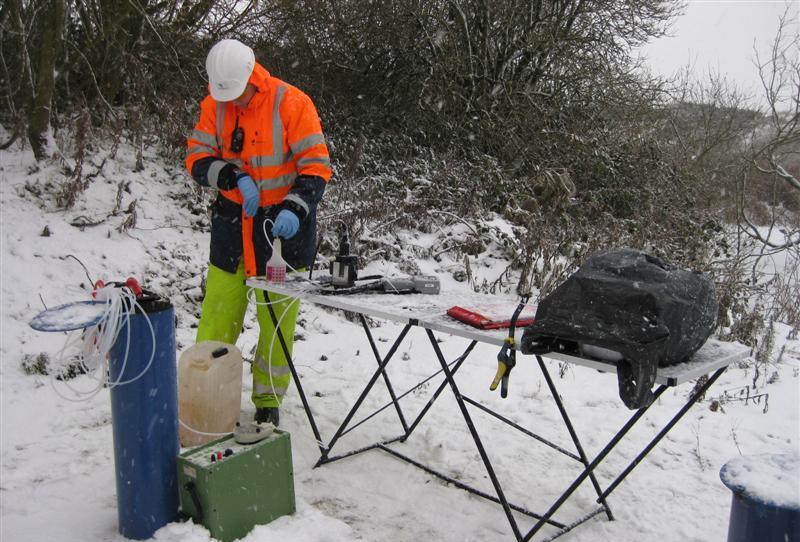

Advantages & Disadvantages of Low Flow Sampling

September 24, 2014
Many groundwater sampling techniques are derived from techniques or regulatory standards which are used in the United States of America. The US EPA has and is leading the way to more precise and effective sampling techniques.
Low flow or micro purging is now an accepted method in the UK following the publication of BS 10175:2011 in March 2011. With this type of sampling, a pump is hung in the well opposite the most contaminated zone in the well screen and adjusted to a very low speed. There is no need to renew (purge) the water in the blind section of the well. By using this method, the volume of the purge water can be reduced, sometimes significantly over the conventional purging method.
During low flow sampling water quality indicator parameters are measured (pH, EC, DO and increasingly turbidity: EC and DO are the best stability indicators) until stability is achieved. After three successive readings of the water quality indicator parameters have stabilized (recorded after a minimum of one tubing, pump and flow-cell volume) per cycle then sampling can begin. It is customary, but not written in stone that drawdown is kept within 10 and 20cm and this should be regularly checked with a Dip Meter. This technique is excellent for slow recovering wells and saves much time and purge water disposal volumes. A dedicated pumping system for each well is recommended. This ensures minimal mixing of the stagnant water above the screen.
If we return to the US to review the advantages and disadvantages of low flow sampling the EPA’s: LOW-FLOW (MINIMAL DRAWDOWN) GROUND-WATER SAMPLING PROCEDURES cites many of advantages and disadvantages of Low Flow Sampling.
Advantages:
– samples which are representative of the mobile load of contaminants present (dissolved and colloid-associated)
– minimal disturbance of the sampling point thereby minimizing sampling artefacts
– less operator variability, greater operator control
– reduced stress on the formation (minimal drawdown)
– less mixing of stagnant casing water with formation water
– reduced need for filtration and, therefore, less time required for sampling
– smaller purging volume which decreases waste disposal costs and sampling time
– better sample consistency; reduced artificial sample variability.
Disadvantages:
– higher initial capital costs
– greater set-up time in the field
– need to transport additional equipment to and from the site
– increased training needs
– resistance to change on the part of sampling practitioners
– concern that new data will indicate a change in conditions and trigger an action.
To test for yourself whether low flow sampling is the best method for you it is worth considering that there are no unusual requirements for groundwater sampling devices when using low-flow, minimal drawdown techniques. The major concern is that the equipment gives consistent results and minimal disturbance of the sample across a range of low flow rates (i.e., < 0.5 L/min). Pumping rates that cause minimal to no drawdown in one well could easily cause significant drawdown in another well. In this sense, the pump should not cause undue pressure or temperature changes or physical disturbance on the water sample over a reasonable sampling range. Consistency in operation is critical to meet accuracy and precision goals.
Van Walt offers a variety of sampling equipment for low-flow (minimal drawdown) purging and sampling including peristaltic pumps, bladder pumps and electrical submersible pumps. Devices which lend themselves to both dedication and consistent operation at definable low-flow rates are preferred. It is desirable that the pump be easily adjustable and operates reliably at these lower flow rates.
For more information call +44 (0)1428 661 660.
You might also be interested in...
Van Walt Guidelines for sampling for PFAS in Groundwater
November 13, 2024We need to make clear, that at the time of writing, there are no ISO or EN standards which deal with the sampling of groundwater for PFAS.
Read MoreSpot measurement v. continuous environmental monitoring
August 25, 2023Environmental monitoring has developed considerably over the years. From the time when a consultant went out monthly or quarterly with a dip tape to monitor the groundwater level in a borehole, wind forward...
Read MoreMeasuring Nitrates (NO3, NO3-N) in the field
June 20, 2023The interest in Nitrates is nothing new. One way or another we have been measuring them for half a century.
Read MoreVan Walt Environmental Equipment
A small selection of our environmental equipment